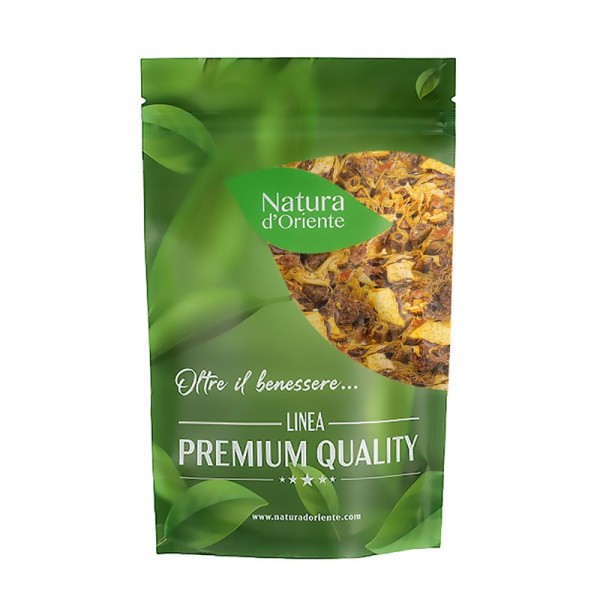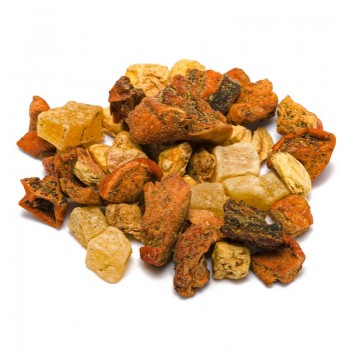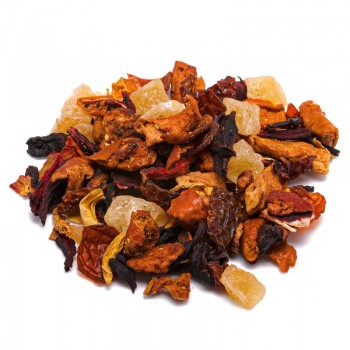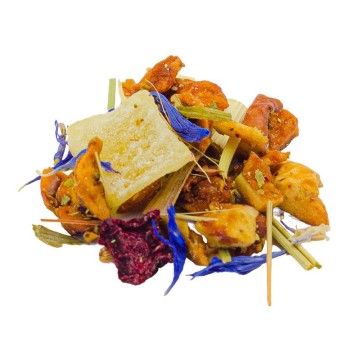This citrus drink with a pungent and fresh flavor is reminiscent of the hot summer months in winter. Citrus fruits bring a breath of sunshine on the cloudiest days. The hot infusion provides benefits and a truly enveloping aroma, which evokes lime. In summer, the infusion adapts perfectly to our thirst-quenching needs. In fact, it is preferable to prepare it as a cold drink. The fruit notes of this infusion range from citrus fruits to oriental delights, for a refreshing and slightly exotic taste. Lemon, orange and mandarin make a summery, pleasant and relaxing citrus flavour; with flavor notes enhanced by pineapple, dates and grapes. The final nuances of the marigold flowers make the infusion even more aromatic and pleasant.
Blood orange and mandarin lime infusion: properties and benefits
By drinking this infusion, you obtain the properties of the fruits that compose it, and in particular the antioxidants contained in citrus fruits. Furthermore, we know that these fruits contain many vitamins, from the famous vitamin C useful for our well-being in terms of the immune system and the beauty of the skin. Furthermore, the drink makes vitamin P contained in the mandarin available, which fights water retention, and group B vitamins. Another positive element is the purifying and remineralizing factor of the blood orange which promotes the correct activity of the liver in disposing of fats. The blood orange is also rich in anthocyanins, antioxidants less common in other citrus fruits and beneficial for our body. By taking this infusion of blood orange lime and mandarin, you obtain the virtues of the antioxidants contained in citrus fruits, the flavonoids. An aid against free radicals that damage cells, and a resource to counteract digestive irritations. The infusion is particularly gentle on the stomach, promoting the digestion and absorption of food – the active ingredients of citrus fruits. Dates and grapes are also rich in protective antioxidants, useful for intestinal well-being and for replacing any sweetener, through the natural sugar of the infusion. Furthermore, the scent profile of the infusion promotes relaxation and rest. The components of this drink, as a whole, constitute a source of well-being for our body, if consumed constantly.
Origins and history of cultivation
This infusion has various ingredients in the mixture, among which we will consider blood orange and mandarin. The blood orange is particular, since it represents a variety of orange with a crimson-colored, bloody and juicy pulp. Its characteristic is due to the presence of anthocyanin antioxidants, usually uncommon in citrus fruits but present in this variant, probably originating from the Southern Mediterranean. Blood oranges are known to have been grown in this area since the eighteenth century, common in Italy and Spain. In ancient times, the plants were used mainly for ornamental purposes. In terms of botanical origin, this orange represents a natural mutation of the orange (itself a hybrid, probably between the pomelo and the mandarin). The reason for the diffusion and value of these oranges is given by the anthocyanin antioxidants that give the blood color. They develop in the presence of low but not rigid night temperatures, as happens in the cold Mediterranean season.
To date, the Sicilian blood orange even has a PGI (protected geographical indication) denomination, with varieties such as Tarocco e Moro and Sanguinello of Spanish origin. They are also cultivated in Spain and the United States and in other favorable regions, to be used as fresh fruit, for jams, desserts, ice creams, orange juices, etc. The mandarin, together with other citrus fruits (lemon, orange, grapefruit, etc.) is a species of oriental origin. It is at the basis of the birth of other citrus fruits, and in crossing with the pomelo it generated the orange; further crossings created grapefruit and lemon. The original wild mandarin probably came from southern China, a region now divided between China, India and Myanmar and at the foot of the Himalayas. If they were initially inedible, they began to diversify with mutations and were among the best-known citrus fruits in the East (about 4,000 years ago).
Historically, in addition to consumption, some varieties were used in Asia as gifts and temple decorations. Over the centuries, the plant spread westward along trade routes, until it reached the Mediterranean. Today, many cultivations and varieties of mandarins are widespread in the world, in the subtropical regions of Europe and America. The pulp is juicy and full of flavourand, like the oil extracted from the fragrant peel, they are ingredients for desserts, aromas and liqueurs.
Fruits and flowers
There are many components of the infusion, and we mention the most important ones. The blood orange is botanically Citrus sinensis, as the fruit of a Mediterranean mutation of the plant, originally from Asia. They show expanded leaves, very fragrant star-shaped white orange flowers, and ovoid fruits. The skin is red and slightly rough, and hides a juicy pulp of an intense red colour. The blood orange has almost no seeds. The botanical name of the lemon is Citrus ×limon, a small tree or bush in the Rutaceae family. Famous for its fragrant leaves and edible fruits, the plant can reach an average height of 3 to 6 meters if it is not pruned. The oval fruit shows a rather thick outer rind in some varieties, with many oil glands. The mandarin is a small evergreen tree (Citrus reticulata Blanco, 1837) belonging to the Rutaceae family.
It grows to about 2-3 meters, showing very fragrant but smaller leaves than other citrus fruits. The fruit has a spheroidal shape, with a light orange, very sweet pulp, which has numerous seeds inside. The date palm (Phoenix dactylifera) is a tree of the Arecaceae family. Perhaps native to present-day Iraq, the palm also grows in the irrigable deserts of North Africa and the Middle East. The plant is about 20 meters tall, and gives the date: a fruit with a single seed, or drupe, which varies depending on the cultivation conditions and the variety of palm on which it grows. Calendula officinalis is a herbaceous plant, which grows up to about 70 centimeters. It is an annual plant, and belongs to the Asteraceae family. Its yellow-orange flowers, which is why it is also called fiorrancio, are edible, known for their beneficial and soothing cosmetic qualities.
Nutritional values of blood orange lime and mandarin infusion
The content of the infusion makes group B vitamins and vitamins A, C, P available. It contains various antioxidants (flavonoids), essential oils, and minerals potassium, phosphorus, magnesium and copper
How to use the ingredients in the infusion The drink is obtained by inserting approximately 3-5 grams of the mixture into a cup (250 ml), with water at a temperature of 100 °C. Leave to infuse for 10 to 12 minutes before drinking. Add honey or sugar, if desired (even if the infusion is naturally sweet).
Blood orange and mandarin lime infusion: side effects and contraindications
To avoid unwanted effects, it is necessary to respect the recommended doses of the infusion, and not to exceed its consumption for too long periods. Excessive intake can cause reflux and gastric acidity, nausea, headache. Caution advised for pregnant or breastfeeding women.











 No reward points for this product.
No reward points for this product.













![infuso pesca melone [Natura d'Oriente]](https://www.naturadoriente.com/3535-home_default/infused-peach-melon.jpg)

